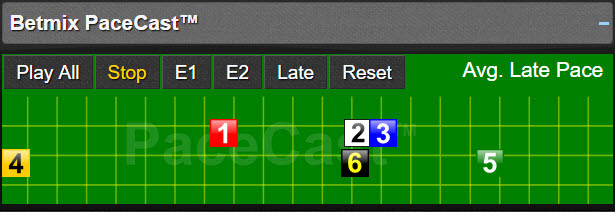There are many great tools in Betmix to help you handicap. Creating a mix (a group of factors and weights) that are specific to a race type is always going to be the best approach. Some people may find that process a bit confusing at first, so to help new users get out of the gate quickly with Betmix we have a very simple and visual tool called Handicapping Overview. You can use this great guide in any race in Betmix using the BirdDog interface.
The Handicapping Overview will display the rankings of each horse in the race based on 19 different handicapping models. At the bottom of the chart all of those rankings are rolled up into a consensus with point totals.

Top 10 – Uses a weighted blend of the 10 most important factors for the race type
Win% – Uses a weighted blend of the factors with the best win percentages
Hit The Board – Uses factors that predict high percentage of horses that ran 1, 2 or 3
Blend – Uses a mix of factors from each category (Speed, Pace, Earnings, etc.)
Longshot – Uses a mix based on factors with high win ROI numbers.
Overall Rankings – Uses the ideal setting from Overall Rankings. This is based on the setting that predicted the most exactas within the top 4 ranked horses of the sample of similar races.
FACTOR GROUPS
These rankings will give you an idea of how the horses rank within each category using a weighted mix of the factors within that group. Factors that are more highly ranked within the group will be given more weight. You can click on the buttons the represent each factor to see the mix used. To the left of each Factor Group button you will see a “Signal Strength” icon that indicates how strong the factor group is in relation to the other groups. Four Green Bars in the icon is the best and means that the factors within that group are most important for the race type you are handicapping.
SCORE & BIRDDOG
The “Score” rankings are based on ranking the horses using the default factors in the main horse table:
Last Finish Position, Lengths Beaten, Speed Last Race and Class Difference. The score rankings are computed by looking at each horse's rank within each of those factors and they give you a solid look at horses most qualified to compete in today's race.
The “BirdDog” rankings use the top 10 factors from the BirdDog table. This table looks at a large number of similar races with the same amount of starters as the race you are handicapping. If you are handicapping a 6f dirt claiming race with 8 starters, the BirdDog stats will be based on a large group of races that were 6f dirt with exactly 8 starters. The BirdDog table lets you see how often a horse wins when ranked at a certain position. The BirdDog ranks takes the 10 best factors for the race type and computes a score from that.
MixBot
The MixBot performs a few tasks for you very quickly. It searches the database for the most recent similar race (Track, distance, surface, class) and then runs MixMaker to find out how that race was optimally handicapped. It will then apply that mix to the race you are currently handicapping. It will then repeat the process for the most recent similar race won by a favorite, medium priced horse and most recent similar race won by a longshot. The results of these mixes will provide you with a very accurate way of looking at today's race.
COMBINED RANKINGS
The combined results of all of the rankings (Quick Handicapping, Factor Groups, Score & BirdDog)













